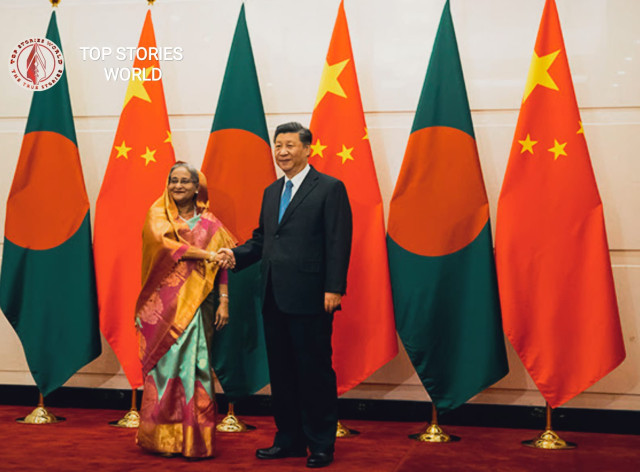Risky Business: China's Arms Race with Bangladesh Escalates - BNS Sheikh Hasina is Just the Beginning!
- Posted on April 7, 2023
- News
- By Arijit Dutta
- 365 Views
The Awami League government, led by Sheikh Hasina, is approaching the end of its term in Dhaka but is also gearing up for upcoming elections. Recently, Prime Minister Hasina inaugurated the BNS Sheikh Hasina, a $1.2 billion submarine base built by China in Cox's Bazar as part of Bangladesh Army's 'Forces Goal 2030' defense plan outlined in 2009. This move has raised concerns in New Delhi, as the base is strategically located at the mouth of the Bay of Bengal, dangerously close to the Indian Navy's Andaman and Nicobar Command.

Submarines navigating in the Bay of Bengal face challenges due to its narrow and shallow passage connecting to the Indian Ocean, demanding high maneuverability to safely submerge beneath the water's surface. The limited maneuverability of submarines in the Bay of Bengal makes them susceptible to attacks and potential loss during conflicts, which could hinder the Bangladesh Navy's ability to deploy attack-capable submarines at the berth. However, it's noteworthy that Bangladesh, which has procured submarines from China, may acquire more in the future, potentially allowing the Chinese navy (PLAN) to utilize the facility under the pretext of anti-piracy operations.

"China's
Strategic Roadmap: Deepening Ties and Expanding Influence in Bangladesh"
China and Bangladesh signed a Defense
Cooperation Agreement in December 2002, which encompasses military training and
defense production. As per Chinese government designations, Dhaka and Beijing
are recognized as being in a "strategic partnership of cooperation".
Furthermore, Bangladesh holds the distinction of being China's second-largest
customer for defense procurement.
According to the most recent report by the
Stockholm International Peace Research Institute (SIPRI) on arms sales during
the period of 2016-2020, Bangladesh accounted for 17 percent of all Chinese
defense exports, with Pakistan being the top customer, procuring 38 percent of
Chinese defense exports. Notably, Beijing is ranked as the world's fifth
largest exporter of arms and weapons, constituting 5.2 percent of global arms
sales, as per the SIPRI factsheet.
The Defense Cooperation Agreement signed in
2002 has enabled Beijing to foster relationships with successive governments in
Dhaka, positioning Bangladesh as a potential customer for Chinese arms. Over
time, China has expanded the range of items in its arms export list for
Bangladesh, steadily increasing its offerings.
Since 2002, Bangladesh has become a
significant element in China's expansionist ambitions in South Asia. While
Dhaka seeks economic, trade, and industrial technology to address its
unemployment challenges, Beijing has managed to persuade Bangladesh to enhance
its military capabilities to assert its influence in potential maritime
conflicts, such as the one that occurred with Myanmar in 2016.
During that same year, China provided
Bangladesh with two 056 corvettes, namely BNS Shadhinota and BNS Prottoy. These
ships were equipped with naval guns of 76 mm and 30 mm, as well as anti-ship
and surface-to-air missile systems.
Bangladesh successfully resolved its maritime
disputes with Myanmar in 2012 and with India in 2014. As a result, it was able
to expand its sovereign claim over the Exclusive Economic Zone (EEZ) by
approximately 100,000 square kilometers, an area nearly equivalent to its
landmass. Although India was slow in proposing a technical support mechanism
for exploratory purposes, Beijing promptly provided military and naval hardware
to assist Dhaka in safeguarding its recently acquired maritime resources.

What
India Needs to Do: Key Imperatives for Action"
Following India's provision of a $500 million
credit line to Bangladesh in 2019, which became operational in 2022, Dhaka
expressed interest in procuring military hardware items from New Delhi. This
included all-terrain special-purpose vehicles, helicopters, and a maintenance
contract for Russian-origin equipment such as Mi-17-1V helicopters, Antonov
An-32 aircraft, and MiG-29 jets, which India also extensively utilizes.
As India aims to assist Dhaka in achieving its
Forces Goal 2030 program during an election year, it is crucial to convey to
Bangladesh's political establishment that engaging in an unnecessary arms race
in the region would be futile. China's long-term strategy involves cultivating
South Asian nations through arms deals and deceptive trade models, leading them
into a debt trap and perpetuating an endless arms race.
Approximately 52 years after the conclusion of
the 1971 Liberation War, a younger generation of Bangladeshis, who are now
eligible to vote, is seeking employment opportunities, economic growth, and
political stability. It is imperative for India's mission in Dhaka to engage
with all segments of Bangladeshi society and its political entities to
highlight the significance of addressing concerns that directly affect the
everyday lives of the citizens.
The economic advancement of Bangladesh hinges
upon effectively leveraging regional connectivity initiatives and integrating
its economy and military strategy with India's Bharat Mala and Sagar Mala
projects. It is imperative for New Delhi and Dhaka to actively collaborate on
Look East Act East endeavors. Furthermore, India should consider extending its
coastline projects on the East Coast to include Bangladesh and Myanmar within
the framework of IORA (Indian Ocean Rim Association) and BIMSTEC (Bay of Bengal
Initiative for Multi-Sectoral Technical and Economic Cooperation).
For more updates keep visiting our website
www.topstoriesworld.com where we provide unbiased, true, and top stories of the
world.




